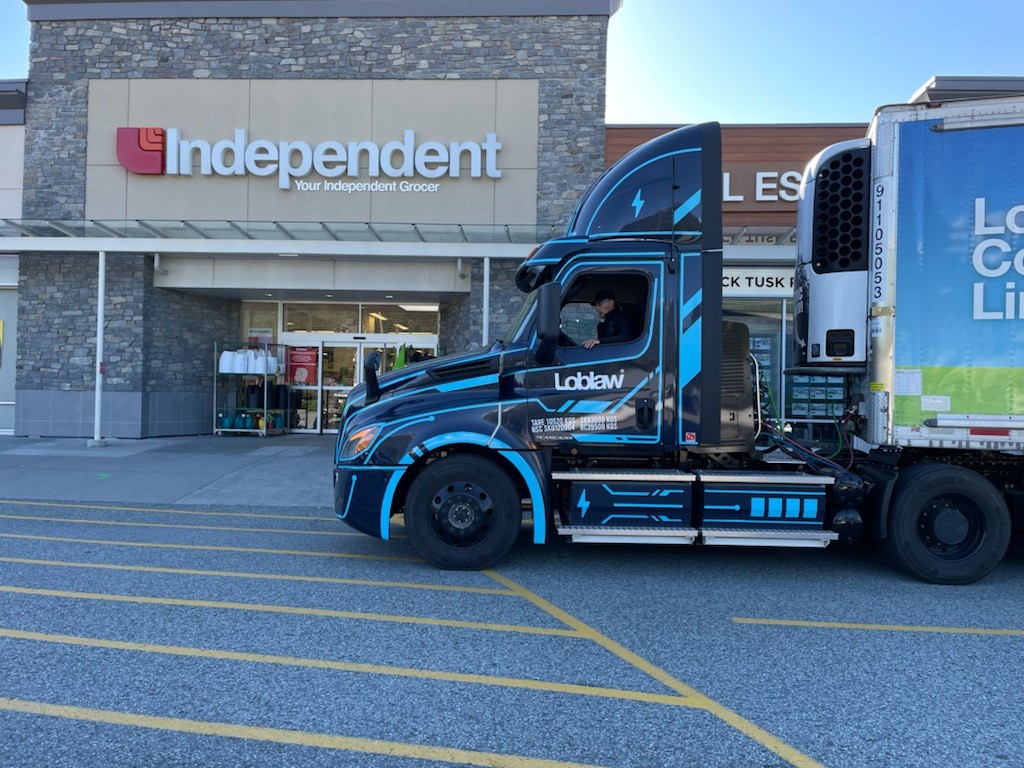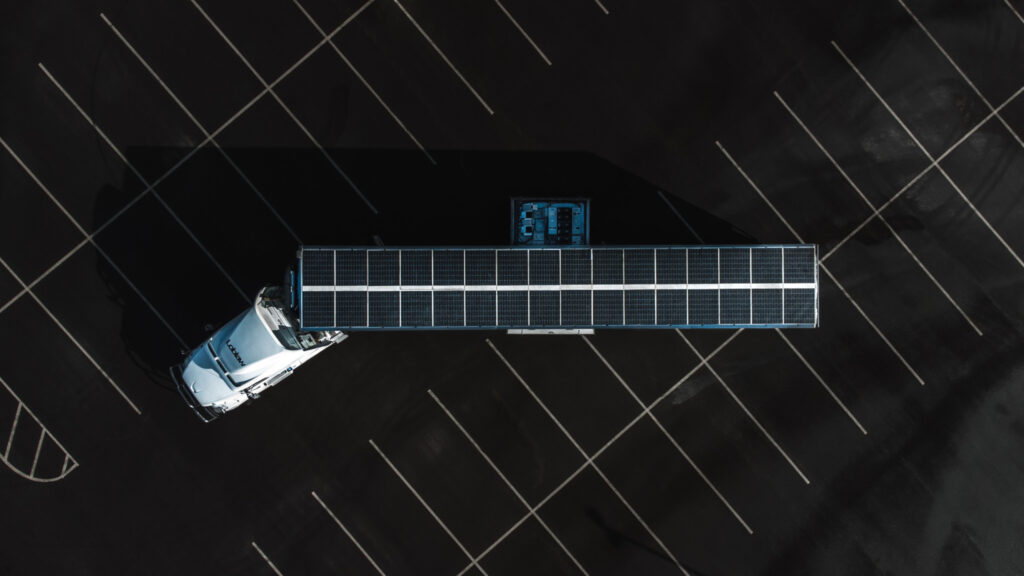Loblaw takes to the road with zero emissions
Loblaw was quick to raise its hand to order some of North America’s first Freightliner eCascadias. Now Canada’s largest grocer has officially tested one of the first units on the road – and even used the battery-electric tractor to pull a reefer that features a rooftop solar array.
The end result was one of the first examples of a tractor-trailer moving refrigerated freight without generating any carbon dioxide emissions.

“One driver, you couldn’t wipe the smile off his face,” says senior director – transport maintenance Wayne Scott, referring to one of the drivers who was particularly taken by the quiet-running equipment.
The inaugural run of the eCascadia itself, a refrigerated load shipped between a South Surrey Distribution Center and a store in Squamish, B.C., was completed in late June. But by late August it was also pulling the solar-powered trailer on a trio of trips ranging between 33 and 43 km in length.
“It was a matter of putting it all together,” Scott says.
The trailer developed with Westhill Innovation moved to Calgary for further tests in early September, while the eCascadia returns to Portland for other demonstrations.
The initial tests were established in B.C. because of the jurisdiction’s proximity to Daimler Trucks North America’s headquarters in Portland, Ore., he adds.
It all offered some of the earliest insights into how battery-electric Class 8 trucks could perform in a Canadian setting.

The first run involved a 147-mile (237-km) return journey and a 22,933-lb. payload and a traditional reefer. Leaving the distribution center with a full charge, the truck returned with a 15% state of charge. Within a week, drivers were able to boost that to 20%, after learning ways to better leverage the regenerative braking, Scott says.
Officially the eCascadia’s range runs between 210-257 km between charges, drawing on 390 kWh of usable battery. The truck has a top speed of 97 km/h and a curb weight of 23,500 lb. It can reach an 80% state of charge in under three hours.
“It actually performs better than I thought,” Scott says, comparing the 2.0 kilowatts per mile to the promised 2.2 kilowatts per mile. “For a prototype vehicle to be in that area, I’m pretty happy.”
A sweet spot for the fleet
The truck’s range also falls into a sweet spot for the grocer’s private fleet.
“On our outbound fleet we probably do roughly 200,000 to 225,000 runs a year under 250 miles [400 km],” Scott explains.
The demonstration truck also has a lower battery capacity than production models. The prototype comes with 410 kWh of battery power, but the new units will feature 550 kWh. This should increase the maximum range to around 250 miles (400 km), Scott says.
It isn’t the only way Loblaw plans to increase the potential range. A data logger mounted in the truck fed data to Freightliner teams in Portland, gathering insights to coach the driver.
“We think it will get better,” Scott says. “Drivers have to make sure they don’t use the [foundation] brakes to get as much regenerative energy as possible to extend the range of the truck”.
The first permanent versions of the Class 8 trucks will be based at facilities in Quebec. “We’ve got a higher concentration of runs in that area,” Scott says. The province also provides grants and incentives for battery-electric trucks and related infrastructure. A further benefit involves the source of clean hydroelectric power.
But that’s only the beginning. The company has already set one of Canada’s most aggressive electrification mandates.
“Our goal is to electrify the fleet by 2030,” Scott says, also referring to plans to put four electric shunt trucks into the Quebec market next year. “We might have some legacy-type equipment like trailers and reefers, but they’ll all have shore power.”
That will involve investments in trucks and infrastructure alike. Since Loblaw distribution centers are relatively new, however, most have access to the required power nearby, he says.
Maintenance will be left to local Freightliner dealerships, though.
“Predominantly, it’s going to be going to the dealerships until it becomes a little more mainstream,” Scott says. He doesn’t expect the trucks to spend much time in the service bay. No emissions-related service or oil changes will be needed.
“I’m hoping not to use the repair facility really all that much. That’s part of the payback.”
Have your say
This is a moderated forum. Comments will no longer be published unless they are accompanied by a first and last name and a verifiable email address. (Today's Trucking will not publish or share the email address.) Profane language and content deemed to be libelous, racist, or threatening in nature will not be published under any circumstances.
It is not true to say it is zero emissions, there are plenty of emissions involved in the entire process it is simply zero emissions at the point of use
I too was testing the e Cascadia this Summer for Bison Transport and was quite impressed in many ways and the few issues i expect will be resolved as technology improves.
Hi John, many thanks for your excellent report. Those trucks are equipped with two ZF AVE130 axles with one E-motor on each wheel end. I am supporting this project from ZF side and would be more then happy to bring you in contact with our folks from the ZF E-mobility truck and bus component side if you like. Please let me know. Many thanks. Regards Frank Schelkle, local ZF Service Manager North-/Central America
I find this article very interesting that in western Canada, Loblaws is investing in new electric truck technology but in Ontario in March of 2021 they sold off the tractors and returned all of their leased tractors at their Cambridge distribution centre. This terminated approximately 200 company drivers and allowed them to bring in third party carriers to replace their trucks and employees. I guess that is one way to reduce your carbon footprint and shift the reduction to outside carriers by eliminating your own equipment. I am interested to see how the third party carriers will adapt to electric technology in their equipment to acheive Loblaws goals fo carbon reduction.
In the UK and EU there is a lot of innovation in the engineless transport refrigeration options with Solar and Eaxles one part of the story.
If you want to know more then LinkedIn to me Norman Highnam MinstR
Wow!
Putting solar panels of the roof of the trailer is a brilliant idea.
It’ll be interesting to follow the rollout of this technology and see how it evolves.